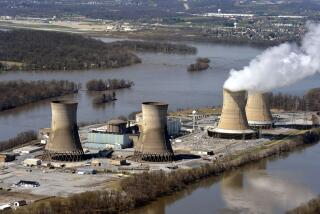New York Agrees to Scuttle Never-Used Nuclear Plant
- Share via
NEW YORK — New York state officials and the Long Island Lighting Co. agreed in principle Thursday to tear down the Shoreham nuclear power plant, which has never sold its electricity--the first time in U.S. history that a completed nuclear generating station will be scuttled before it opens.
The deal, subject to complicated conditions, is a major victory for anti-nuclear activists who have argued that the facility was inherently unsafe because it would be impossible to evacuate residents on densely populated Long Island in the event of a catastrophe. The plant is located on Long Island’s north shore in Suffolk County, 55 miles from New York City.
State and local officials also argued that it would be impossible to evacuate residents should an accident occur, since Long Island is surrounded by water on three sides and normal traffic patterns are so heavy. They refused to participate in drawing up an emergency plan.
The complicated agreement calls in essence for New York state to buy the $5.3-billion plant for $1 in return for allowing the utility to raise its rates by 5% annually for at least three years and perhaps as many as seven more years.
“Shoreham had to die. Shoreham will die,” said Gov. Mario M. Cuomo, who opposed the nuclear generating station as a safety threat. “ . . . We are going to decommission and dismantle it.”
“The bottom line here was a safety issue from day one,” said Vincent Tese, the state’s chief negotiator in talks with Long Island Lighting. “You couldn’t get away from that issue.”
“The key issue here is the end of the beast, the end of Shoreham,” rejoiced Richard Kessel, executive director of the New York State Consumer Protection Board, who fought the facility, completed at more than 80 times its original cost estimates.
“The era of nuclear power is probably over,” Kessel predicted. “Safety comes first. While we are not saying we are totally against nuclear power, safety and the environment are very crucial issues. A nuclear plant should not open in an area where you can’t move people out in case of an accident.”
Shoreham, designed as an 809-megawatt plant, was completed in 1983. Since 1985 it has been operating at low power for testing purposes. For over two decades, the facility, which forced Long Island Lighting to the brink of bankruptcy, has come to symbolize both the concerns of anti-nuclear activists and the frustrations of the nuclear industry.
Utilities have proposed no new nuclear power plants in the last decade, and since construction of Shoreham began, more than 100 plants have been canceled. None of those, however, had reached the point where actual generating tests had begun.
Pressed for License
Cuomo, who shared the concerns of local officials about the impossibility of evacuating the island, began negotiations to close the facility. While Long Island Lighting was involved in the delicate and complicated discussions with the state over many months, its lawyers were pressing the Nuclear Regulatory Commission for a commercial license.
After the NRC did away with a rule in October that required states and local governments to take part in evacuation plans, Cuomo redoubled his efforts to close Shoreham.
In March, the Long Island Power Authority, an agency created by New York state, made a bid to purchase Long Island Lighting. The bid failed, but added impetus to the talks.
At 1:40 a.m. Thursday both sides announced a tentative agreement to close and dismantle Shoreham. Long Island Lighting will continue to operate as a utility. New non-nuclear generating plants will be built by the New York State Power Authority to ensure that residents of Long Island have an adequate supply of electricity.
The agreement is subject to the utility being able to receive an investment grade rating, allowing it to refinance $2 billion in debt at lower interest rates.
“We think the package will allow the bond rating services to restore LILCO to investment grade,” said Gary G. Fryer, the governor’s press secretary. “We think that the utility will have a large tax writeoff by closing the plant and this combined with the rate agreements will restore the company to financial viability. This restoration allows the company to refinance its enormous debt at a far lower cost and that allows it to eventually lower rates on Long Island.”
A spokesman for the utility said that until final papers are signed, Long Island Lighting still will pursue its efforts to obtain a full operating license for Shoreham. But he said there is a “standstill clause” in the tentative agreement. The clause provides that, if the NRC grants such a license, Shoreham will not operate above the current test level.
Legislative Approval
The entire package must be approved by the New York State Public Service Commission and some parts of the agreement need legislative approval. Any plan to tear down Shoreham must be passed upon by the NRC.
In addition to its tentative settlement with the state, Long Island Lighting is seeking to negotiate the end to an $8.7-billion lawsuit filed against it by Suffolk County officials on Long Island and by individual homeowners.
At a news conference, Cuomo stressed that Shoreham should be destroyed to prevent any chance of its resurrection.
In Washington, the American Nuclear Energy Council, which has lobbied for nuclear plants, criticized the tentative agreement.
“Gov. Cuomo is putting all his eggs in one basket and trusting that the price of oil will stay low over the next 15 years,” a spokesman for the organization said. “The writing was on the wall last September when the Public Service Commission denied LILCO’s request for a rate increase. (The message was) if Shoreham is licensed, LILCO won’t get its rate increase.”
Dan Reicher, a spokesman for the Natural Resources Defense Council, saw the agreement differently.
“The Chernobyl reactor was the event more than Three Mile Island that has galvanized public opinion about these facilities,” Reicher said. “Without Chernobyl, we probably would have seen a different set of events. There is a realization of the real disasters that can result.”
Times researcher Eileen V. Quigley contributed to this story.
More to Read
Sign up for Essential California
The most important California stories and recommendations in your inbox every morning.
You may occasionally receive promotional content from the Los Angeles Times.













